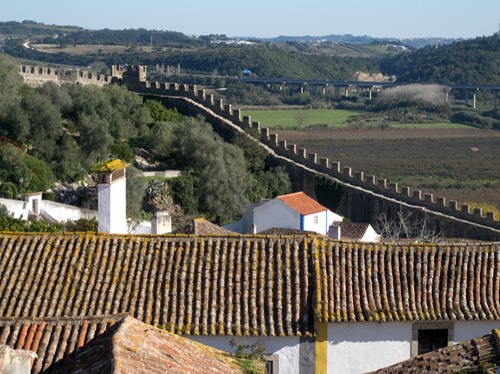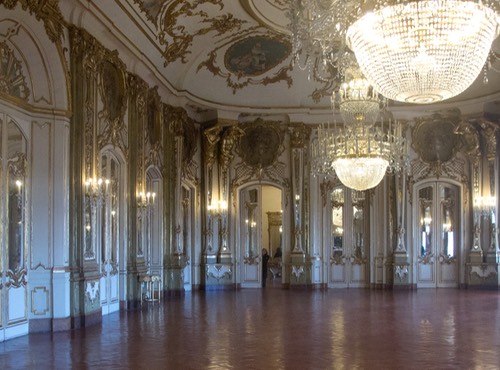Monday 8th December 2014.

Back to Obidos today, no queue back to the motorway, but still a queue from around 2km from the town. This time we stuck it out and on entering town found every car park jammed solid with cars and those without parking places driving around getting more and more frustrated. Travelling up one narrow street we spied a couple of parking spaces, we also saw why they were still empty - you would have to park on sand with your wheels almost over a two foot drop into an occupied car park and the sand looked quite soft. A Portuguese chap saw me back into the space, I was so close to the edge I had to exit the car by jumping down the drop. We asked the chap why were all these people in this sleepy little town and were told it’s a Christmas market that runs from 5th December until 4th January. Whether this included Christmas day we don’t know, but the last time we were in Portugal for Christmas we did go to the local fish market on Christmas day and all the shops and restaurants were open.
As we walked through the town we could see how important the market was. Within the town walls a christmas village is built, it is the main focus of the festival and an entry fee is charged. The queue for tickets into the village was so long we decided not to go in - a decision we now regret but hey ho perhaps next year.
Tuesday 9th December 2014.
Moving day - Just a quick trot 123km (76m) down the motorway to a site we have been to before Orbitur Guincho, a site just outside the bustling seaside town of Cascais, but we are here not to visit Cascais but to visit Sintra.
Sintra was made a UNESCO World Heritage Site in 1995 and is described on UNESCO’s web site thus:-
“. . . In the 19th century Sintra became the first centre of European Romantic architecture. Ferdinand II turned a ruined monastery into a castle where this new sensitivity was displayed in the use of Gothic, Egyptian, Moorish and Renaissance elements and in the creation of a park blending local and exotic species of trees. Other fine dwellings, built along the same lines in the surrounding serra , created a unique combination of parks and gardens which influenced the development of landscape architecture throughout Europe. . .”
There are more castles, palaces, ornamental gardens, monasteries etc., than you could shake a stick at in the immediate area of Sintra, We saw Pena Palace on our last visit in 2011 so this visit we hope to see a few more.
When we stayed on this camp site before we had discovered a great cafe/restaurant just around the corner. Thinking we might eat out tonight we wandered round there but the place was closed. However as we had got used to the idea of going out for dinner we went to the site bar to eat. It was a good decision, the food was cooked from scratch. I had Peixe-espada preto or black scabbard fish while Sue had lamb chops - lovely.
Wednesday 10th December 2014.

Up into the hills above Sintra to visit the Moorish Castle today. There is little other than the walls with a keep at each end, but the walk around the walls and up to the high parts of the two keeps gave stunning vistas in all directions. The walls are not the place for those of a nervous disposition, they are awfully high and feel very exposed. From the southern keep of the castle you got a magnificent view of the Pena Palace newly redecorated in its original bright yellow, shocking pink and brick red colours. It looks like a child’s garish fantasy.
Thursday 11th December 2014.
Having been to the most northerly point in western Europe on 15th July today we visited the most western point of mainland Europe, Cabo da Roca.
Friday 12th December 2014.
The weather the last two days, and today, has been quite good so we are packing what we can in before the rain comes back. Our first visit today was to the Convento dos Capuchos or Capuchin Convent, inhabited by Franciscan friars and built in 1560 by Alvaro de Castro, its tiny cells and chapel are lined with cork and it is consequently also known as convento cortiça or cork convent. When I say tiny cells that is what I mean, each cell is too small for a man to lie down, although in a few he may lay across the cell if not very tall, and the door being around 1.3m high and 450cm wide a friar would need to keep slim.
Our second visit of the day was to the Palácio Nacional de Sintra,or National Palace of Sintra right in the centre of the historic centre of Sintra and described on the Sintra web site as :-
“. . . The thousand-year-old history of the Palace of the Town of Sintra began during the Muslim occupation of the Iberian Peninsula. Already mentioned in texts from the 11th century, the original Moorish Palace became the property of the Portuguese Crown after the conquest of the city of Lisbon by Afonso Henriques, the first King of Portugal, in 1147. It was first subjected to alteration work in 1281, in the reign of King Dinis, and new extensions were later added to the building over time, in the reigns of the kings Dinis, João I and Manuel I, although it has largely maintained its present-day outline since the mid-16th century. The vertical arrangement of its spaces, adapting to the nature of the terrain; the intimate organisation of the interior courtyards, outdoor spaces in which one can hear the sound of running water; the windows with their surmounted arches; and the walls covered in glazed tiles with rich geometrical patterns, are all features that underline the Moorish links of the craftsmen who built and embellished the Palace . . . “
Sadly when we came out of the palace we discovered it was raining
Saturday 13th December 2014.
It’s still raining, in fact it has been “persisting” down all night so we decided to go window shopping in the Portuguese version of Lakeside. Sadly I proved that I cannot count to three and took the second instead of the third exit from a roundabout and 100yards or so from the roundabout the road split into two, I saw one leg had a 2.1m height restriction so turned down the other only to find that that leg also had a 2.1m height restriction. Oh bugger with our top box we are just under 2.2m high. I had no option but to reverse back the way we had come scrubbing the driver side tyres against the kerb to enable the (pretty well constant) traffic, provided they did the same, to get past me on that single carriage way road. It’s a good job Portuguese drivers are generally patient and well mannered, particularly the one who stopped the traffic to allow me to reverse onto the roundabout.

Sunday 14th December 2014.
The sun is shining, well more or less, so another palace visit today.We went to Palácio Nacional de Queluz halfway between here and Lisbon. The magnificent throne room was, for me, the highlight of the visit it’s mirrored walls and doors, crystal candelabras and gold trimmings it seemed to transport you back to a more elegant age.
This palace is also the home of the Portuguese School of Equestrian Art who give frequent equestrian shows and well as riding lessons.
The management of the palace has recently come under the Parques de Sintra-Monte da Lua S.A. (PSML) whose mission statement is:-
“ . . .Parques de Sintra-Monte da Lua S.A. (PSML) has, among other missions, the responsibility to manage the most important natural and cultural values located in the area of the Cultural Landscape of Sintra and in Queluz: the Park and Palace of Pena, the Gardens and the Palace of Monserrate, the Moorish Castle, the Convent of the Capuchos, the Garden and Chalet of the Countess of Edla and, since 2012, the National Palaces of Sintra and Queluz and the Portuguese School of Equestrian Art based at the historic Gardens of Queluz. . .”
This means that serious restoration work is being carried out on the palace and in years to come it will be even more of a joy to visit.